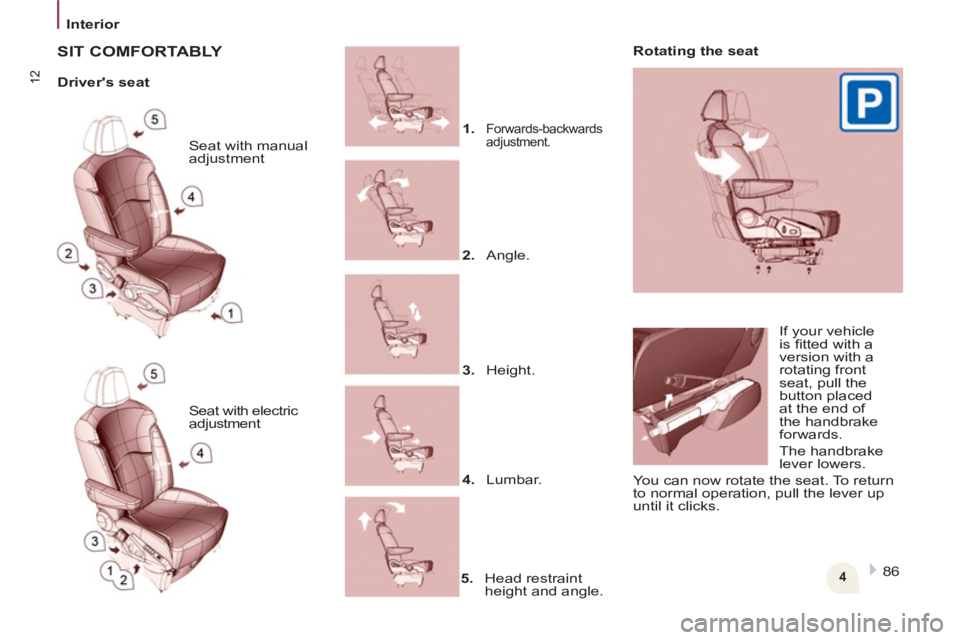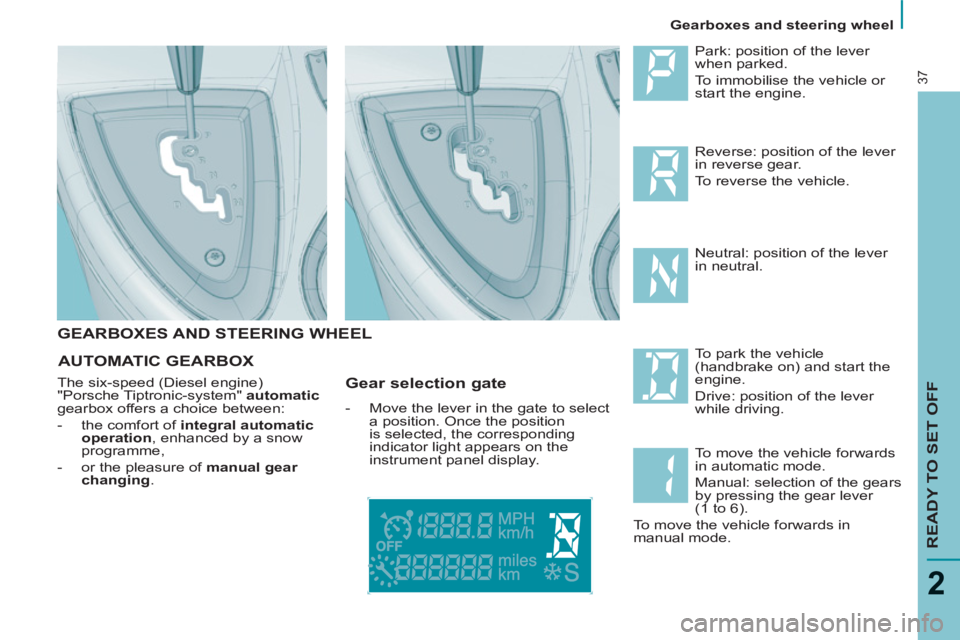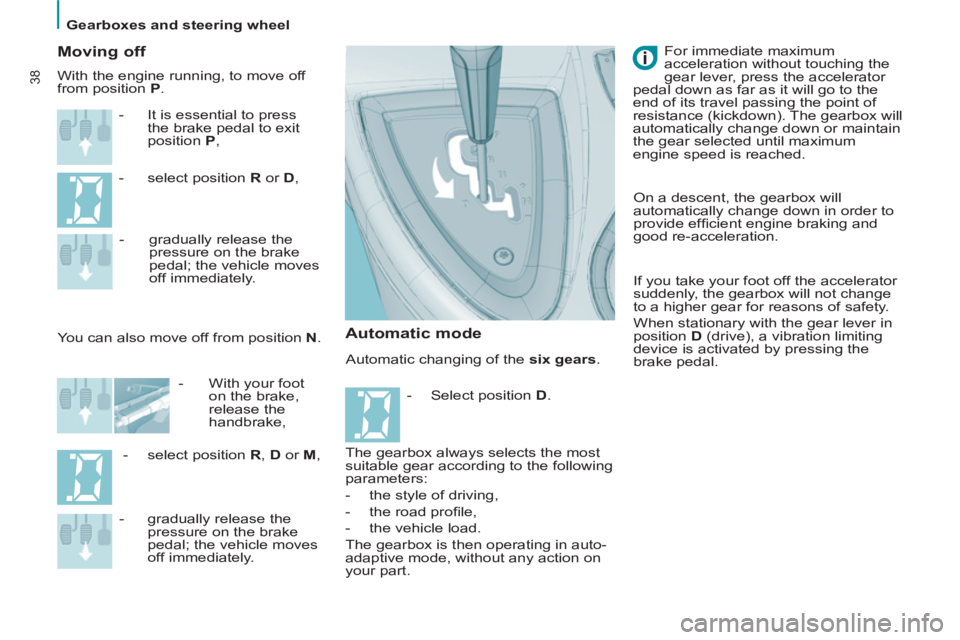2013 Peugeot 807 brake
[x] Cancel search: brakePage 4 of 234

2
Contents
4. SAFETY 85-102
Driving safety 86
Handbrake 86
Hazard warning lights 86
Parking assistance 87
ABS and EBFD 88
Horn 88
Emergency braking
assistance 88
ASR and ESP 89
Tyre under-infl ation
detection 90
Seat belts 91
Airbags 93
Passenger air bag
disarming 93
Child seats 97
Isofi x seats 99
Recommended seats 100
Monitoring mirror 102 Steering wheel
controls 43
Lighting 43
Windscreen wipers 46
Cruise control 48
Speed limiter 51
Ventilation 54
De-icing and demisting 55
Seats 59
Front 59
Rear 64
Bench seat 69
Modularity 71
Comfort and safety 75
Layout 75
Courtesy lights 80
Sun visor 81
Mirrors and windows 82
3. EASE OF USE and
COMFORT 43-84
Presentation 4
Communication 4
Exterior 6
Interior 8
Identifi cation features 17
1. FAMILIARISATION 4-17
Accesses 18
Keys 18
Alarm 22
Doors 23
Child safety 25
Tailgate 25
Sunroofs 26
Instruments and controls 27
Control block 27
Instrument panels 28
Warning lights 29
Indicators, Display 34
Gearbox
Automatic 37
Manual 41
Steering
wheel adjustment 41
Starting and stopping 42
2. READY
TO SET OFF 18-42
Page 11 of 234

9
1
FAMILIARISATIO
N
Interior
13.
Battery / Fuse box.
14.
Passenger airbag.
15.
Passenger's lower glove box / Fuse
box / RCA sockets.
16.
Air conditioning controls.
17.
Lighter /
12 V accessories socket.
18.
Hazard warning lights switch.
19.
Storage compartment or additional
telematics control.
20.
Cooled compartment.
21.
Ashtray / Can holder.
22.
Seat adjustment control.
23.
Storage compartment.
24.
Handbrake - on the left.
1.
Electric mirror controls.
- Electric window controls.
- Deactivation of the rear electric
controls.
2.
Driver's upper glove box.
3.
Central adjustable vents.
4.
Audio equipment or GPS
multimedia audio equipment with
fl ap.
5.
Instrument panel / Large colour
display.
6.
Sunshine and passenger
compartment temperature sensor.
7.
Passenger's upper glove box.
25.
Bonnet release under cover - on
the left.
26.
Acoustic windscreen.
INTERIOR OVERVIEW
SETTING THE DATE AND
TIME
For more information about
this adjustment, refer to the
"Setting the date and time" section of
the "In-car technology" chapter.
ADDITIONAL HEATER
With the engine at idle
or when the vehicle is
stationary, it is normal
to notice a high-pitched
whistling and a slight emission of
smoke and odour.
Bluetooth.
8.
Windscreen demisting vents.
9.
Speaker (tweeter).
10.
Front window demisting vents.
11 .
Passenger airbag disarming switch,
if fi tted on your vehicle.
12.
Side adjustable vent.
Page 14 of 234

4
12
Interior
86 Seat with manual
adjustment
Seat with electric
adjustment If your vehicle
is fi tted with a
version with a
rotating front
seat, pull the
button placed
at the end of
the handbrake
forwards.
The handbrake
lever lowers.
You can now rotate the seat. To return
to normal operation, pull the lever up
until it clicks.
1.
Forwards-backwards
adjustment.
2.
Angle.
3.
Height.
4.
Lumbar.
5.
Head restraint
height and angle.
Rotating the seat
SIT COMFORTABLY
Driver's seat
Page 17 of 234

4
244
7
6
4 3 3
415
1
FAMILIARISATIO
N
Interior
Battery
11 6
Child monitoring mirror
102
Disarming the passenger's front airbag
96
Opening control
Sliding side doors from the
inside. 24
Handbrake
86
Bonnet opening controls
The bonnet opening control
is a red handle under a
cover. Release the bonnet
from inside the vehicle then
go to the front and insert
your hand under the badge
to open and raise the bonnet,
place the strut in its location
securely. 111
Safety auto-reverse.
97 102 84 83
Electric windows/Safety auto-reverse
CHILD SAFETY
Monitoring mirror.
Child seats. On a steep gradient,
guide the side door
manually to assist
closing.
closing
Page 31 of 234

Instruments and controls
READY TO SET OFF
2
29
WARNING LIGHTS
Each time the engine is started: a series of warning lights comes on applying a self-test check. They switch off almost
immediately. With the engine running: the warning light becomes a warning if it remains on continuously or fl ashes. This
initial warning may be accompanied by an audible signal and a message which appears on the display. "Do not ignore
these warnings."
Warning light is indicates Solution - action
STOP
lit, associated
with another
warning
light and
accompanied
by a message
on the display. major faults linked with the
"Brake fl uid level", "Engine
oil pressure", "Coolant
temperature", "Electronic
brake force distribution",
"Power steering" and
"Punctured tyre" warning
lights.
You must stop, park, switch off the ignition
and call a PEUGEOT dealer.
Handbrake/
Brake fl uid
level/EBFD
lit. handbrake applied or not
released correctly. Releasing the handbrake switches off the warning
light. Chapter 2, "Starting and stopping" section.
lit. low brake fl uid level. Top up using a fl uid recommended by PEUGEOT.
remaining on,
even though the
level is correct and
associated with the
ABS warning light.
failure of the electronic
brake force distribution.
You must stop, park, switch off the ignition
and call a PEUGEOT dealer.
Engine oil
pressure
lit while driving. insuffi cient pressure. Park, switch off the ignition and allow to cool.
Visually check the level. Chapter 6, "Levels"
section.
remaining on,
even though
the level is
correct. major fault. Call a PEUGEOT dealer.
Page 39 of 234

Gearboxes and steering wheel
READY TO SET OFF
2
37
GEARBOXES AND STEERING WHEEL
Park: position of the lever
when parked.
To immobilise the vehicle or
start the engine.
To park the vehicle
(handbrake on) and start the
engine.
Drive: position of the lever
while driving. Reverse: position of the lever
in reverse gear.
To reverse the vehicle.
Neutral: position of the lever
in neutral.
To move the vehicle forwards
in automatic mode.
Manual: selection of the gears
by pressing the gear lever
(1 to 6).
To move the vehicle forwards in
manual mode.
AUTOMATIC GEARBOX
The six-speed (Diesel engine)
"Porsche Tiptronic-system" automatic
gearbox offers a choice between:
- the comfort of integral automatic
operation
, enhanced by a snow
programme,
- or the pleasure of manual gear
changing
.
Gear selection gate
- Move the lever in the gate to select
a position. Once the position
is selected, the corresponding
indicator light appears on the
instrument panel display.
Page 40 of 234

Gearboxes and steering wheel
38
Automatic changing of the six gears
.
Moving off
- It is essential to press
the brake pedal to exit
position P
,
- select position R
or D
,
You can also move off from position N
.
- gradually release the
pressure on the brake
pedal; the vehicle moves
off immediately.
- With your foot
on the brake,
release the
handbrake,
- select position R
, D
or M
,
- gradually release the
pressure on the brake
pedal; the vehicle moves
off immediately.
The gearbox always selects the most
suitable gear according to the following
parameters:
- the style of driving,
- the road profi le,
- the vehicle load.
The gearbox is then operating in auto-
adaptive mode, without any action on
your part. For immediate maximum
acceleration without touching the
gear lever, press the accelerator
pedal down as far as it will go to the
end of its travel passing the point of
resistance (kickdown). The gearbox will
automatically change down or maintain
the gear selected until maximum
engine speed is reached. With the engine running, to move off
from position P
.
Automatic mode
On a descent, the gearbox will
automatically change down in order to
provide effi cient engine braking and
good re-acceleration.
If you take your foot off the accelerator
suddenly, the gearbox will not change
to a higher gear for reasons of safety.
When stationary with the gear lever in
position D
(drive), a vibration limiting
device is activated by pressing the
brake pedal.
- Select position D
.
Page 41 of 234

Gearboxes and steering wheel
READY TO SET OFF
2
39
- press the lever to the +
sign to change to a higher
gear, from 1 to 6,
- conversely, press the lever
to the - sign to change to a
lower gear. You can change from position D
(automatic mode) to position M
(manual mode) at any time.
Stopping the vehicle, starting
the engine
Reverse gear
- Select position R
, with the
vehicle stationary and the
engine at idle.
If the battery is fl at and the lever is
in position P
, it will be impossible
to change to another position.
- Select position P
to
immobilise the vehicle
or to start the engine
,
with the handbrake on
or off.
- You can also select
position N
to park
or to
start the engine
, with the
handbrake on.
If position N
is engaged
inadvertently while driving, allow
the engine to return to idle before
engaging position D
to accelerate.
Manual mode
Manual changing of the gears by
pressing.
- Select lever position M
, In manual mode, it is only possible to
change from one gear to another if
the vehicle speed and engine speed
permit. If they do not, the vehicle will
operate temporarily in automatic mode.
When the vehicle is stationary or
moving very slowly, the gearbox
automatically selects gear 1.
The �7 (snow) programme does not
operate in manual mode.